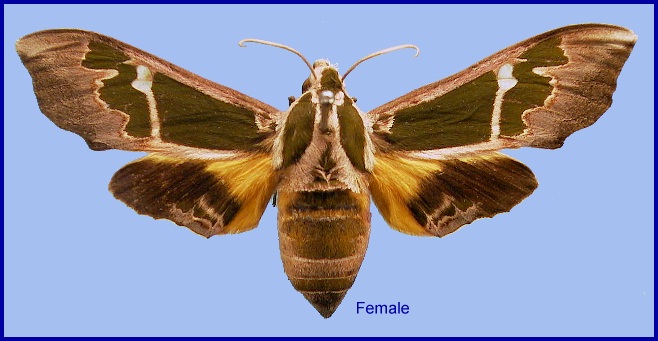
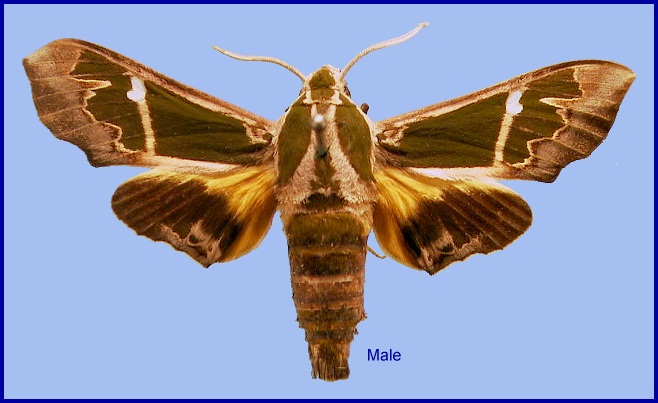
Microlophia sculpta Felder, R., [1874], in Felder, Felder & Rogenhofer, Reise öst. Fregatte Novara (Zool.) 2 (Abt. 2): pl. 75, fig. 9. Type locality: Siam [Thailand].
Synonym. Microlophia sculpta Felder, R., [1874].
Synonym. Cizara schausi Clark, 1923.
Wingspan: 50--70mm. Similar to Cizara ardeniae but immediately distinguishable by the yellow base and inner margin of the hindwing upperside. Forewing upperside similar to Cizara ardeniae but distal edge to the central paler green area irregular.
In the male genitalia, harpe curved, of even width, obtuse. Phallus very short with very long bidentate process extending caudally.
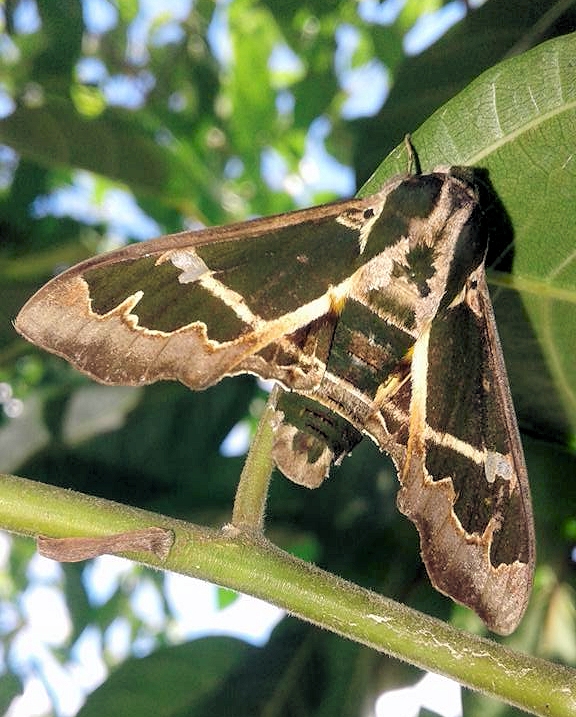
OVUM: Broadly ovoid (1.8 x 1.6mm), surface smooth and shiny to the naked eye, but under the microscope seen to be covered with small shallow, irregular pits. Hatch after about five days (Bell & Scott, 1937).
LARVA: Full-fed 70mm; width 11mm.; horn 9mm. In the first instar, head broad and round; body nearly cylindrical and of smaller diameter than head. Horn very long, straight, bifid, the two arms short, conical, diverging at right angles to each other, each arm bearing a small hair. Surface of the head and body smooth and dull; horn shiny, smooth for the distal half, the rest tuberculate covered densely with minute hairs with two or three branches. Colour of head and body very pale honey-colour; horn black. In the second instar, shape as in the first instar. Surface of head and body dull; head and body, in addition to the main hairs, closely covered with forked hairs. Head dark green; body pale green dotted with white. There is a large black dot on the front margin of segment 6, and small dots on front margins of 5, 7 and 8, all on the dorsal line. There is a very sharply defined dorso-lateral white stripe from middle of segment 2 to base of horn. Latter black, the sides of base green. By the third instar, body of greater diameter than head; horn of medium length, slightly up-curved, bifid. Surface of head and body dull and smooth. Forked hairs as in the second instar. Colour of head dark green; body paler green dotted with white; black dorsal spots as in second instar. The dorso-lateral stripe narrow and faint on the anterior segments, broad and well defined on the posterior segments. There is also a dark, narrow dorsal stripe from segment 7 to base of horn. Basal half of horn fuscous-green, distal half first pale yellow, then black. The spiracle on segment 6 larger than the rest and surrounded by a narrow black circle. In the fourth instar, head small and round; body tapering sharply frontad from segment 6; horn straight, minutely bifid. Colour as in third instar except that the dots are yellow instead of white. Dorso-lateral stripe yellow on 11 and 12. There are some indistinct darkish oblique lateral stripes; spiracles white edged with black on each side, that on 6 larger than the rest and surrounded by bluish, outside which is a narrow circle of black. Horn green, base paler and tip black (Bell & Scott, 1937).
In the final instar, head round; true clypeus over one-third length of head, equilaterally triangular; false clypeus reaching to one-half length of head, apex very broadly rounded; labrum half as long as clypeus; ligula rather longer than labrum and not quite so broad, kidney-shaped with narrow lobes. Surface of head dull, covered with minute, shiny, conical tubercles; labrum longitudinally furrowed. Body tapering sharply frontad from segments 5 to 2, the latter being of about the same diameter as the head; rest of body nearly cylindrical. Horn stout, tapering evenly to a sharp point, and sharply down-curved. Surface of body dull and smooth except for some small scattered tubercles on segment 2 and anal flap. The subspiracular hair on segment 6 to 11 with a short stem branching into three arms, each arm dividing into two, and then again branched forming a horizontal fan. Horn covered with small, shiny, pointed tubercles directed distad (Bell & Scott, 1937).
In colour, head green, tubercles white. Labrum emerald green; ligula pink, the sinus edged with white; basal segment of antenna green, rest rose-colour; mandible green, tip broadly dark reddish-brown. Body green, segment 2 with a narrow saddle-like marking green, covered with minute white dots. Remaining segments with a transverse row of dots around each secondary ring, these dots white and very small on 3 and 4, larger on 5, larger still and yellow on 6 to 12. There is a dorso-lateral stripe from 2 to base of horn, which is very faint, whitish on l and 3, clearly defined and yellow on 4, very faint again on 5 and 6. On 7 to 10 the stripe is reddish-brown, broken near the hind margin of each segment and crescent-shaped on each segment, the lower, concave side of each crescent broadly suffused with chalky-white. On segment 11 the stripe is straight and becomes whitish again on 12 to base of horn. Spiracle of segment 6 lying in a longitudinally oval ocellus-like marking, blue round the spiracle, then yellowish, the whole edged narrowly with white and then black. Horn brown, the dorso-lateral stripe running up each side for a short distance. Legs translucent white, with a reddish-brown streak down the outer face of basal segment, end-segment kale rose-brown. Shank of prolegs green with reddish-purple distal border, ankles dull black, feet pinkish; claspers the same; anal flap edged with whitish. Spiracles dusky-white, more or less suffused with fuscous (Bell & Scott, 1937).
In the resting position the head and segments 2 and 3 are retracted into 4 which, together with 5, is swollen. The larva is sluggish and moves in a jerky manner. Before pupation it turns livid slate-grey, the white markings turning yellow. Pupation takes place in a rough cocoon on the surface. This stage lasts about twenty-five days (Bell & Scott, 1937).
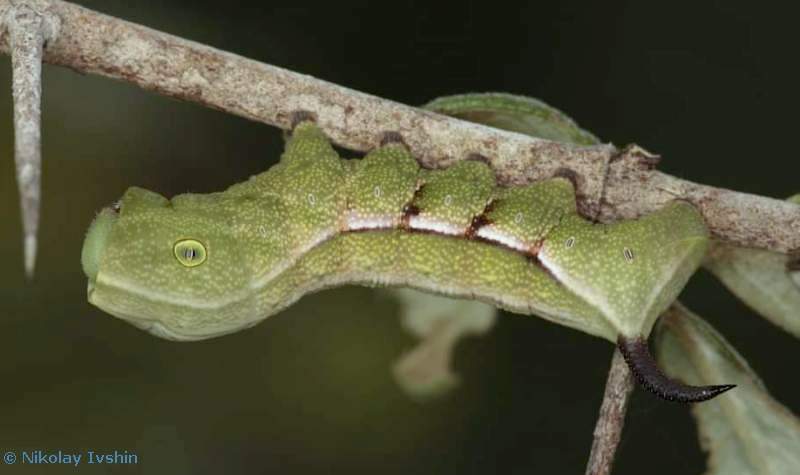
PUPA: 35mm; breadth 11mm. Colour pale ochreous; head and thorax suffused with brown and marbled with darker brown; wing-case suffused with pale brown, and with short, pale transverse lines. Fore and mid-leg banded with very dark brown, nearly black; a pale bracket-shaped marking on fore tibia. Abdomen marbled with dark brown, pinkish ventrally; hind bevels of segments 8 to 10 chocolate-brown. There is a brown interrupted ventral stripe and sculpturing on segment 4. Spiracles and cremaster black; ante-spiracular ridges rusty (Bell & Scott, 1937).
Stout in build, tapering sharply to head and to base of cremaster. Antenna slightly shorter than fore leg, which reaches to middle of wing-case, mid-leg to two-thirds length of wing-case; no coxal piece. Surface shiny. Head, thorax and wing-case obscurely lined in the manner of cracked lacquer. Abdomen very shallowly transversely corrugate; sculpturing on segment 4 in the form of a narrow, transverse, central ridge on each side of the dorsal line with a channel in front of and behind it. Ante-spiracular ridges in the form of seven (on segment 9) and six (on 10 and 11) short, parallel ridges. Spiracle of 2 a narrow slit lying between the raised hind margin of 2 and a short, rounded transverse lobe projecting from the front margin of 3. Remaining spiracles broadly oval, flush, the surface rising slightly to the central slit, which has raised edges. Cremaster a stout knob, ending in a short shaft set with five or six short hooks and some tubercles along the lateral edges based on each side; upper surface very rugose (Bell & Scott, 1937).
The pupa is active, squirming energetically when touched, and making a low rustling sound. This stage lasts about sixteen days.
[Illustrated in Eitschberger & Ihle, 2008].
Larval hostplants. Catunaregam spinosa (Rubiaceae) in India (Bell & Scott, 1937). [This plant is also known by the synonym Randia dumetorum.]
In Laos and Thailand, recorded from Gardinia jasminoides (Eitschberger & Ihle, 2008).
China: ?Yunnan.
Southern and eastern India, Burma/Myanmar, ?southwestern China, Thailand, Laos, Vietnam and Cambodia.
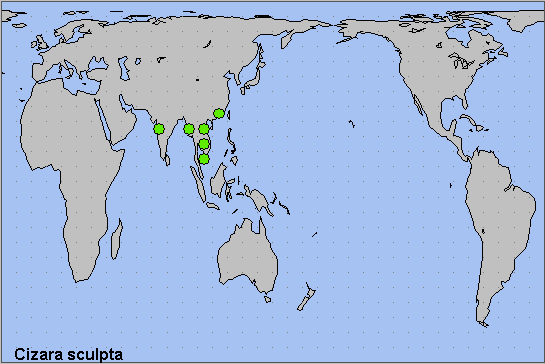
 Return to Sphingidae of the Eastern Palaearctic species list
Return to Sphingidae of the Eastern Palaearctic species list